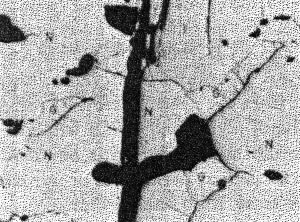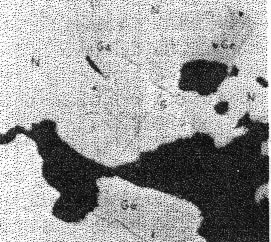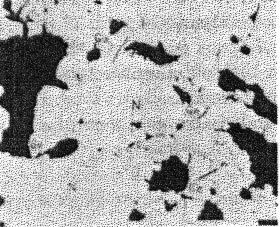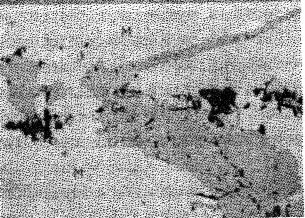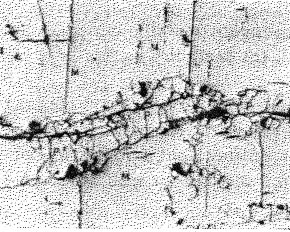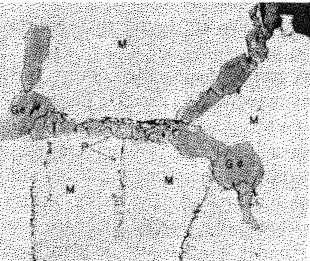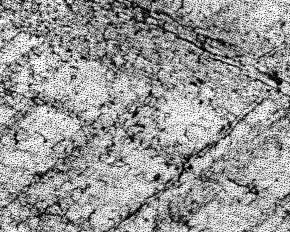
|
|
Volume 28, pages 257-271, 1943 GOLD-NICKEL MINERALIZATION AT ALISTOS, SINALOA, MEXICO PHILIP KRIEGER* AND ARTHUR F. HAGNER#. ABSTRACT An occurrence of gold-nickel ore from Alistos, Mexico, is described. It consists of two types: (1) gold-niccolite, containing minor amounts of gersdorffite and maucherite; (2) gold-millerite, with associated pentlandite, gersdorffite, and violarite. The mineral assemblage, particularly the association of native gold with niccolite and primary millerite, is considered unusual. The ore is believed to have originated from solutions which produced alteration in a peridotite stock. The latter cuts surrounding flat-lying volcanics, the chief one being an enstatite latite. The mineralization responsible for the unusual group of minerals is interpreted as being hypogene. INTRODUCTION AND ACKNOWLEDGMENTS Several years ago an interesting suite of gold and nickel ore from the Gloria property at Alistos, Sinaloa, Mexico, was submitted to the authors for study. Work was undertaken as a joint project and was nearing completion when interrupted by Professor Krieger's unfortunately fatal accident. The junior author has completed the project and presents this study as a joint contribution, both in appreciation of the inspiration received from a former professor and friend, and as a description of a unique ore. The mineral assemblage of the Gloria ore, particularly the association of abundant native gold with niccolite, and the presence of primary millerite, also containing gold, is extraordinary. This association, together with pentlandite and rare minerals, such as maucherite, violarite, and gersdorffite, is unusual. The occurrence of pentlandite free from associated pyrrhotite is also noteworthy. Native gold has been but rarely observed with niccolite, and in deposits where it has been described it is commonly associated with base metal sulphides and sulpho-salts of silver. In the Gloria occurrence at Alistos, however, the metallic constituents associated with gold consist almost entirely of nickel-bearing minerals. Field data and additional material for study were obtained from Mr. W. H. Triplett and Mr. F. L. Wingfield, of the Cia. Minera de Penoles, S. A. Grateful acknowledgment is made to these gentlemen for their cooperation and to the Cia. Minera de Penoles, S. A., for permission to publish the results of this study. The writers are also indebted to Dr. Paul F. Kerr of Columbia University for suggestions and a critical reading of the manuscript, and for the use of x-ray equipment; to Dr. Charles Behre of Columbia University for reading the manuscript; and to Dr. Wilbur G. Valentine of Brooklyn College and Mr. Ralph J. Holmes of Columbia University for information and advice.
LOCATION The Gloria property is located at Alistos, in the Badiraguato mining district, Sinaloa, Mexico, near the boundary of Sinaloa with Chihuahua and Durango. The nearest post office is at Tameapa, 72 miles northwest of Culiacan, Sinaloa. FIELD RELATIONS The property is situated in a region composed chiefly of deeply eroded, nearly flat-lying, Tertiary volcanic rocks consisting of andesite, lathe, and rhyolite, which make up the plateau area of western Mexico (1). At Alistos they are intruded by a small peridotite stock, now largely altered to amphibole, pyroxene, serpentine, and mica. The gold-nickel ore occurs in narrow veins within lathe, near the border of the altered peridotite intrusive. Distribution of metallic constituents within the veins is highly erratic and commercial values have been found chiefly as small pockets or "bonanzas." The highest grade ore, some of which assayed up to 8.9 ounces of gold per ton and 0.90 ounces of silver, was localized near the intersection of two veins, one striking N. 35° W., the other N. 18° W. Both veins have been explored and mined for gold content some distance from the intersection, but apparently do not contain sufficient mineralization to warrant extensive development. The property is thus of interest, not so much as a commercial development of gold-nickel ore, but because of its unique and interesting mineral content. PETROGRAPHY Examination of the rocks associated with the ore shows two fairly distinct types. One is dark green and fine grained, with a hackly fracture and smooth surfaces produced by slight slippages in the rock. In the field, rock of this type forms a small stock which has cut the surrounding volcanics. The rock has been partially metamorphosed or altered by hydrothermal solutions and thoroughly recrystallized, with introduction of pyrite and magnetite. It is believed to be an altered peridotite which is now an incipient tremolite-actinolite schist. The other rock is light buff, fine textured, and massive, and resembles a hornfels. In the field it forms a nearly horizontal sheet, believed to represent an original volcanic rock, presumably a flow, now extensively altered by hydrothermal solutions and cut by veinlets consisting chiefly of gangue minerals. It is thought to be an altered and veined enstatite latite. Altered Peridotite. The structure of the altered peridotite is obscure and the texture variable. The rock is now composed largely of tremolite, actinolite, and other recrystallization products, such as diopside, chlorite, epidote, siderite, sericite, serpentine, and magnetite. These minerals form interlocking aggregates, many individual grains of which are as much as 2 mm. across. This texture suggests that the original rock was coarse grained. A streaking of magnetite and pyrite grains which might be regarded as an original flow structure, is believed to have formed during hydrothermal alteration and recrystallization under pressure. This belief is supported by the fact that no other original structures have been preserved. Textures and occasional remnants indicate that the original rock was an intrusive which presumably contained pyroxene, magnetite, and perhaps some olivine, with little or no feldspar and quartz. Such a rock would fall into the general classification of peridotites, probably a pyroxenite. The rock might now be called an incipient tremolite-actinolite schist. Enstatite Latite. Aside from the indistinct flow structure, the original structure of the latite has been largely obliterated by alteration. A number of euhedral phenocrysts of pyroxene, up to 3 mm. in diameter, were identified by their outlines. These crystals occur in a dense recrystallized matrix. In these phenocrysts there are obscure patches believed to be relicts of an original schiller structure, on which basis the mineral has been judged to be a member of the enstatite-hypersthene series. The original phenocrysts have been hydrothermally altered to aggregates of diopside, with small amounts of epidote, uralite, and carbonate. The matrix, crystals of which average 0.05 mm. in diameter, varies from nearly pure oligoclase-andesine in places to areas in which there are are numerous diopside.grains. Small amounts of orthoclase, hornblende, and apatite occur as primary minerals, but no quartz was found. Much of the feldspar may be recrystallized material. It is comparatively fresh, alteration to sericite being confined to limited areas. It is uncertain whether the diopside in the matrix is primary or an alteration product. Small quantities of zoisite and leucoxene are present as alteration materials. Kaolin occurs as a weathering product. The enstatite latite is traversed by veinlets, the largest and oldest of which contain adularia, epidote, and pyrite. The younger veinlets are abundant and conspicuous and carry calcite associated with datolite; others contain datolite alone. The enstatite latite is one of the nearly horizontal Tertiary volcanics of the Alistos region and has been locally intruded by the periodotite. It is not clear whether the alteration of latite and that of the peridotite are related or separate processes. Veining and introduction of adularia, epidote, pyrite, calcite, and datolite in the enstatite latite cannot be correlated with the ore mineralization, and resemble it only in the common occurrence of calcite. It is probable that the introduction was a separate process which preceded the ore mineralization. This is believed to be so because of the difference in the two types of mineralization, and because the latite was apparently crystallized and hydrothermally altered and veined before the intrusion of the peridotite. The ore occurs in veins within latite and is believed to have originated from the nearby peridotite after the alteration of the latite. The ore suite of nickel and cobalt sulphides and arsenides constituting most of the ore mineralization is one commonly associated with basic igneous rocks such as peridotites or pyroxenites. The decline in gold-nickel values away from the peridotite mass also suggests that the source of the ore was the basic igneous stock. MINERALOGY OF THE ORE In the material studied, two distinct types of gold-bearing nickel ore were found. Each type is readily recognized in the hand specimen. Type 1, the gold-niccolite type, consists of massive niccolite with minor amounts of metallic associates including gold, gersdorffite and maucherite, and gangue. Type 2, the gold-millerite ore, is made up of millerite, pentlandite, gersdorffite, pyrite, and violarite, with minor amounts of gold. The mineral association of each type of ore is distinctive. Millerite, pentlandite, and violarite do not occur in the gold-niccolite type, while niccolite and maucherite are not present in the gold-millerite type. In the material available for study gersdorffite and native gold were the only metallic minerals common to both types of ore. GOLD-NICCOLITE TYPE Gold. In the gold-niccolite ore, gold is either associated with niccolite and gersdorffite, or is found entirely within gangue (Figs. 2, 3). It is, however, far more abundant in niccolite than in any of the other minerals. Much of the gold is quite coarse, some particles measuring up to 0.5 mm. in diameter. Etch tests indicate that the gold may contain some silver. This is supported by an assay of the ore which shows 0.911 ounce of silver, yet no silver mineral is apparent in any of the surfaces. When associated with niccolite, gold commonly occupies an interstitial position between grain boundaries of individual crystals and replaces niccolite (Fig. 2). Gold is also found penetrating fractures in niccolite and is thus considered to be later in sequence than niccolite.
FIG. 3. Intergrowth of native gold (G) and gersdorffite (Ge) within niccolite (N). (X200)
Gold is later than gersdorffite, in part at least, for it occupies small fractures in the latter. On the other hand, it is occasionally intergrown with gersdorffite in a graphic structure and the two minerals may have crystallized in part simultaneously (Fig. 3). Niccolite. Niccolite is by far the most abundant metallic mineral and makes up approximately 90 per cent of all the metallics in this type of ore. In the hand specimen it appears as massive, homogeneous material, often with a crude banded appearance. It is associated with dark green to black, impure carbonate, quartz, and serpentine. Gold is ordinarily not visible except with the microscope, but can sometimes be seen on examination of a polished slab with a hand lens. Microscopic study of polished surfaces of niccolite indicate that it occurs as a mosaic of diversely oriented, interlocking grains, some of which may be 1.0 mm. or more in diameter, although the average size is about 0.5 mm. The grains exhibit the usual optical and physical properties characteristic of niccolite. Small differences in color and hardness due to orientation are distinguishable between different grains. The niccolite has been fractured and veined by gangue, commonly carbonate, and by later metallic minerals. Near the contact of the more massive niccolite with gangue, occasional skeletal outlines of niccolite are found surrounding grains of carbonate. Maucherite. Nearly all the individual grains of niccolite contain tiny rods and blebs of a mineral identified as maucherite (Fig. 2). The small size made it impossible to obtain pure material for microchemical tests, and etch tests alone could not be considered adequate. The mineral was, however, compared with known maucherite from other localities and with niccolite and maucherite prepared synthetically by fusing known mixtures of nickel and arsenic. The synthetically formed niccolite was found to contain rods and blebs of maucherite which could be identified by microchemical and etch tests. Maucherite thus formed was similar to the material from Alistos, both as to physical properties and the manner in which it occurs within niccolite. This mode of occurrence is also consistent with known maucherite from localities described in the literature (2). Maucherite in the Alistos ore is believed to have crystallized simultaneously with niccolite as an exsolution product. It shows no evidence of replacing niccolite, the small rods do not transgress niccolite grains, and they are oriented differently in adjacent grains (Fig. 2). These factors support an origin due to exsolution or unmixing. Gersdorffite. Both types of ore contain a smooth, Bard, white, isotropic mineral with well developed cubical cleavage. Microchemical tests show the presence of nickel and arsenic, and x-ray diffraction patterns correspond to those of gersdorffite from Müsen, Germany, and Liebenstein, Saxony. The mineral is present as irregular patches and veins within niccolite, and distinctly penetrates and replaces niccolite along fractures, between grain boundaries, and along the contact between niccolite and gangue (Fig. 4). Gold is sometimes associated with gersdorffite as mentioned above. Although present in all the polished surfaces studied, gersdorffite makes up but a small proportion of the total metallic mineral content. As both niccolite and maucherite are arsenides of nickel, and gersdorffite is the only sulphide observed in this type of ore, it would indicate that sulphur is present in but minor quantity. Gangue. The first generation of gangue was deposited prior to any of the ore minerals. It consists largely of a fine mosaic of calcite, siderite, and chlorite. This was followed by the introduction of niccolite and maucherite. After the niccolite had crystallized, fracturing and shattering took place affecting both the gangue and niccolite. Along these fractures calcite, ilvaite, gersdorffite, and gold were deposited (Figs. 2, 4). Deposition of these minerals was followed by another period of fracturing, and the cracks were then filled with calcite and actinolite. Oxidation Products. Oxidation has been slight and developed principally as a green coating of annabergite on some of the niccolite. It has affected the ore to a thickness of less than 1 mm. The minerals formed in addition to annabergite are jarosite and limonite. There are also some semi-opaque sugary-white patches forming an indefinite alteration aggregate, an indeterminable reddish aggregate, and a black sooty substance. A small amount of chlorite is present in the gangue and in the oxidized products. In places the chlorite occurs in small, ovoid, limonite stained areas most of which are isotropic, but some show a spherulitic structure and give a poor interference figure. This may be either a late primary mineral or an oxidation product. GOLD-MILLERITE TYPE
The gold-millerite ore is believed to be hypogene in origin. This is supported by the following data: The occurrence of
gersdorffite and gold in both types of ore; the massive, twinned character of millerite; and the fact that pentlandite
cuts the millerite. Gersdorffite is said to be occasionally secondary but this, however, is rare (3). Its association
with niccolite and maucherite is hypogene and it is probably also hypogene in the millerite ore. Millerite is usually
supergene (4) but the possibility of hypogene origin has been recognized (2), and pentlandite may be supergene at times
although no entirely satisfactory evidence has been presented for this belief (5). The massive crystalline, non-fibrous character and early Gold, Only two or three specks of native gold were found in surfaces of this type of ore. These occurred within grains of millerite and do not, therefore, add much to the paragenetic relations (Fig. 5). Because of the association of gold with gersdorffite veinlets, although not actually part of the veinlets, it is thought that the two minerals are closely related in time of deposition. This is supported by the simultaneous crystallization, in part, of gold and gersdorffite in the gold-niccolite ore. Millerite. Millerite is the most abundant constituent in this type of ore. It lacks the usual fibrous structure characteristic of most millerite and is coarsely crystalline, somewhat massive, and exhibits excellent cleavage and polysynthetic twinning. Identification was confirmed by microchemical and etch tests, optical properties, and x-ray diffraction patterns compared with patterns of known millerite. It is judged to be hypogene because of its character and the fact that it is cut by veinlets of both pentlandite and gersdorffite. Since millerite does not occur in the gold-niccolite ore its paragenetic relations with respect to niccolite could not be determined. It precedes both pentlandite and gersdorffite, however, and is thus judged to be one of the earlier metallic minerals. Pentlandite. Pentlandite is abundant in the gold-millerite ore. It occurs as broad, irregular veinlets and patches in millerite, some of which may be several millimeters in length (Fig. 6), and as short, narrow, vein-like stringers almost invariably oriented along cleavage or twinning directions in the millerite (Fig. 7). Octahedral cleavage and irregular fractures are prominent in both varieties of the mineral. The larger veinlets and masses of pentlandite are clearly later than millerite for they penetrate and replace the latter conspicuously. With regard to the smaller stringers, however, the evidence for replacement is far from conclusive. The stringers are so persistently oriented along cleavage and twin directions that it is believed they may represent an exsolution product; the millerite and pentlandite having crystallized simultaneously. The larger veinlets and masses of pentlandite are thought to represent deposition from a slightly later iron- and nickel-bearing solution Violarite. Pentlandite, particularly the larger masses, shows extensive alteration to violarite. Matted intergrowths of the latter penetrate along cleavages anti fractures in pentlandite, often leaving a residual core of unreplaced pentlandite in a mass of violarite (Fig. 9). In all cases this alteration stops abruptly at the contact of millerite or gersdorffite. Violarite probably formed by supergene alteration of pentlandite (2, 6). Because of the occurrence of violarite in minute areas, pure material could not be obtained for chemical or x-ray study. It was impossible, therefore, to distinguish with certainty between violarite and bravoite. The appearance, properties, and absence of intergrown pyrite or marcasite, however, are more typical of violarite than of bravoite (2, 5, 6, 7, 9, 11). Gersdorffite. Gersdorffite has the same occurrence and appearance in the gold-millerite ore as in the gold-niccolite type. It crystallized later than millerite and may be closely related in time of deposition with the gold (Figs. 5, 8). No evidence of the paragenetic relation of gersdorffite to gold was found, but it is somewhat later than pentlandite because veinlets of gersdorffite cut across areas of pentlandite. Pyrite. A considerable amount of pyrite is present in parts of the gold-millerite ore. It occurs in irregular, branching veinlets replacing pentlandite. Upon reaching an area of millerite or gersdorffite, the pyrite stops abruptly. Pyrite has thus selectively replaced pentlandite and has crystallized after the other minerals, with the exception of violarite. It tarnishes rapidly, and, judging from some of the thin sections of oxidized ore, is altering to limonite. This alteration was not observed in polished surfaces of unoxidized ore. Gangue. The gold-millerite ore occurs along fractures and as replacing veinlets in the early gangue material which consists of fine granular calcite. After deposition of millerite, the pentlandite, gold, and gersdorffite were introduced along with some calcite. This was followed by deposition of coarse calcite along fractures in the millerite and early gangue material. Oxidation Products. The oxidized material consists primarily of erythrite, jarosite, and limonite. Apparently erythrite formed by oxidation of millerite because it occurs along fractures and surrounding the borders of some millerite grains. This would indicate that millerite contained cobalt, probably partly replacing nickel. Jarosite is closely associated with pyrite and may represent alteration by potash-bearing waters derived from rocks associated with the ore. PARAGENESIS Gold-Niccolite Ore. Mineralization of the enstatite latite began with the introduction of a mosaic of calcite, siderite, and chlorite. It is difficult to determine how much, if any, of the early gangue material represents highly altered and replaced original rock. Certain patches and streaks, however, contain a large amount of chlorite, in some of which there is a suggestion of an antecedent interlocking crystalline rock structure. The early gangue was followed by the introduction of veins of niccolite and maucherite. Next, fracturing and shattering tools place and along the fractures coarse clear calcite, ilvaite, gold, and gersdorffite were deposited. Gold is in part contemporaneous with gersdorffite, because it occurs in graphic intergrowth with the latter. Gold is also in part later than gersdorffite for it occasionally occupies fractures in it. After the deposition of these minerals, fracturing again occurred and the cracks were filled with calcite and a green, fibrous mineral. This mineral tends to form rosettes and may be actinolite or an iron or nickel-iron arsenate. Gold-Millerite Ore. In this type of ore millerite was the first metallic mineral to crystallize. It occurs along fractures and as a replacing mineral in the early gangue which consists of calcite. Millerite was followed by the introduction of pentlandite, gersdorffite, gold, pyrite, and probably some calcite. Pyrite was the last metallic mineral to form, with the exception of violarite which is a supergene alteration product of pentlandite. Pyrite occurs rimming and replacing pentlandite, but has not affected any of the other minerals. This replacement is apparently selective because gersdorffite and millerite have not been replaced or intruded. The few specks of gold in this ore occur within millerite and closely associated with, but not actually in, veinlets of gersdorffite. The association and the fact that gold is intergrown with gersdorffite in the niccolite ore, suggest that it is also associated in time of deposition in this ore. The introduction of pentlandite, gersdorffite, gold, and pyrite apparently was accompanied by the deposition of a small amount of fine granular calcite. Following the deposition of these minerals fracturing occurred and the cracks were filled with coarse calcite. ORIGIN OF THE ORE It is believed that the source of the gold-nickel ore was the small peridotite or pyroxenite stock cutting the Tertiary volcanic rocks in the vicinity of Alistos. The ore occurs near the border of the peridotite mass in veins within enstatite latite. The occurrence of considerable amounts of nickel sulphides and arsenides, and of a trace of platinum in the assayed gold-niccolite ore, suggest an association with a basic igneous intrusive--in this case peridotite. Exploratory work also indicates that the greatest ore concentration is at the intersection of two veins near the peridotite mass. Ore mineralization decreases away from the peridotite to such an extent that further development of the deposit was discouraged. It seems probable that the ore minerals were introduced by hydrothermal solutions (7). End-stage solutions of the magma attacked the peridotite and altered and recrystallized it under pressure to a rock composed of amphibole, pyroxene, serpentine, magnetite, and mica. The source of the water required for the formation of amphibole and mica, and the carbon dioxide of the calcite may have been circulating ground waters. This is suggested because peridotite magmas are thought to be low in water content (8), and no acid igneous rock younger than the peridotite occurs in the immediate area of the Alistos deposit. The peridotite apparently contained a small amount of nickel which may have been present largely in the olivine. Nickel, calcium, and possibly all of the gold were later taken into solution by hydrothermal attack on the peridotite, and deposited in the latite as veins of nickel sulphides and arsenides and free gold. Some or all of the gold may have been introduced from another source, but the close intergrowths with gersdorffite do not support this assumption, nor is there any other evidence for such a belief. It is thus thought that hydrothermal alteration of the peridotite produced solution of minerals of the rock which were then redeposited in veins in the latite. COMPARISON WITH OTHER DEPOSITS Although the mineralogy of the Alistos deposit is believed to be unique, the hydrothermal origin and association with a basic intrusive have been described in other occurrences. At the nickel-gold deposit near Mount Vernon, Skagit County, Washington, a serpentinized peridotite is intrusive into metamorphosed pre-Tertiary sediments (7). A tabular body of silica-carbonate rock is locally brecciated and contains a cement of sulphides, carbonates, and quartz. In the description of the deposit, Hobbs and Pecora state that they believe "the nickel was originally present in the serpentinized peridotite and that it was dissolved and redistributed by ascending hydrothermal gold-bearing solutions while the serpentine mass was being altered into the silica-carbonate rock." The Mount Vernon deposit is similar to the Alistos occurrence in that native gold is associated with carbonates, pyrite, and serpentine minerals. The rest of the mineralogy, however, is essentially different and consists of quartz, opal, chalcedony, marcasite, bravoite, and chromite. Marcasite contains a trace of nickel and is the most abundant sulphide. The presence of a silica-carbonate rock composed of the above mentioned silica minerals and carbonates, with minor amounts of iron oxides and chromite differs from anything at Alistos. The authors believe that the silica-carbonate rock "was formed by intense alteration of a serpentinized peridotite along a shear zone" (7). Although it contains no native gold, the Copper King mine near Gold Hill, Boulder County, Colorado, more nearly resembles the Alistos deposit in mineralogy than does any other occurrence (9). The ore consists of the nickel minerals polydymite, pentlandite, millerite, niccolite, bravoite, and violarite associated with cobaltite, pyrite, pyrrhotite, chalco pyrite, sphalerite, arsenopyrite, and quartz. The ore occurs "in a lenticular layer of amphibolite in biotite schist of the Idaho Springs formation, half a mile west of the border of a small batholith of the pre-Cambrian Boulder Creek granite. A dike-like body of hornblende-quartz gabbro, related to the granite, is exposed in the lower workings, and many irregular pegmatite dikes cut the schist, amphibolite, and gabbro." The authors believe that "the nickel ore is genetically related to the gabbro" (9). Although the mineralogy of the Copper King deposit is somewhat similar to that at Alistos, the association and concentration differ markedly. Polydymite is the chief primary nickel mineral at Copper King, whereas niccolite and millerite are most abundant at Alistos. Millerite is apparently supergene at Copper King; it is believed to be hypogene at Alistos. Also, pyrrhotite, cobaltite, chalcopyrite, and sphalerite are absent from the Alistos material and considerable gold is present. There are several other deposits which resemble the Alistos occurrence in certain particulars (6, 10, 13). The association and occurrence of native gold in niccolite and in hypogene millerite, the presence of hypogene millerite, and the graphic intergrowth of gold and gersdorffite are believed to differ from any other described occurrences. SUMMARY AND CONCLUSIONS The Alistos gold-nickel deposit is unusual in its mineral assemblage. Native gold is associated with two types of ore both of which are considered to be hypogene: A niccolite type containing maucherite and gersdorffite, and a millerite type containing pentlandite, gersdorffite, pyrite, and supergene violarite. No pyrrhotite was found in either type of ore (14). Two rocks are intimately associated in the field with the ore mineralization; an enstatite latite and a peridotite or pyroxenite. The latite has been altered by hydrothermal attack to a rock composed principally of enstatite, diopside, uralite, epidote, orthoclase, and carbonate. Endstage solutions altered the peridotite to an aggregate of tremolite, actinolite, pyroxene, chlorite, epidote, serpentine, and magnetite. Latite is one of the Tertiary flat-lying volcanics of the Alistos district and has been intruded by the peridotite. Introduction of ore minerals probably took place as the last phase of the hydrothermal alteration of the peridotite. There is little oxidation of either type of ore. The gold-niccolite ore contains a small amount of annabergite, jarosite, limonite, one or two unidentified aggregates, and some chlorite which may be primary or an alteration product. The gold-millerite ore contains a minor quantity of erythrite, jarosite, and limonite. Paragenesis of the gold-niccolite ore is as follows: Deposition of carbonate and chlorite gangue was followed in order by niccolite and maucherite; then fracturing and shattering; introduction of calcite, ilvaite, gold and gersdorffite; again fracturing; deposition of calcite and possibly actinolite. In the gold-millerite ore, fine granular calcite was followed by millerite; then in order by pentlandite, gersdorffite and gold, and pyrite. These were followed by a period of fracturing and the introduction of coarse calcite. Violarite was the last mineral to form and is believed to be supergene. The ore minerals are thought to have originated from the peridotite stock by hydrothermal alteration. End-stage solutions from the peridotite magma, perhaps mixed with circulating ground waters, removed nickel and probably gold from the peridotite and deposited them in the latite as veins of nickel arsenides and sulphides, and native gold. REFERENCES
1. SHELDON, G. L., MOCORITO: Eng. and Min. Jour., 93, 1092 (1912).
TAPS, E. A. H., San Jose de Gracia, a great Mexican gold camp: Eng. and Min. Jour., 88, 640-645 (1909). MERRILL, F. J. H., The mining camps of Sinaloa, Mexico: Eng. and Min. Jour., 82, 635-636 (1906). PAGLIUCHI, F. D., A mining reconnaissance from Mazatlan: Eng. and Min. Jour., 115, 542-546 (1923). 2. SCHNEIDFRHOHN, H., AND RAMDOHR, P., Lehrbuch der Erzmikroskopie, vol. 2 (1931). 3. GENTH, F. A., Contribution to mineralogy: Am. Jour. Sci., 2d ser., 28, 248 (1859). 4. EMMONS, W. H., The enrichment of ore deposits: Bull. U. S. Geol. Survey, 625, 465 (1917). 5._____ , The Principles of Economic Geology: 2d. ed., 424 (1940). SCHOLTZ, D. L., The magmatic nickeliferous ore deposits of East Griqualand and Pondoland, part 1, Trans. Geol. Survey S. Africa, 39 (1936). SHORT, M. N., AND SHANNON, E. V., Violarite and other rare nickel sulphides: Am. Mineral., 15, 1-22 (1930). 7. HOBBS, S. W., AND PECORA, W. T., Nickel-gold deposit near Mount Vernon, Skagit County, Washington: Bull. U. S. Geol. Survey, 931-D, 68-69 (1941). 8. HESS, H. H., The problem of serpentinization, etc.-. Econ. Geol., 28, 634-657 (1933). 9. GODDARD, E. N., AND LOVERING, T. S., Nickel deposit near Gold Hill, Boulder County, Colorado: U. S. Geol. Survey, Bull. 931-0, 349-362 (1942). 10. SANDEFUR, B. T., The geology and paragenesis of the nickel ores of the Cuniptau mine, Goward Nipissing District, Ontario: Econ. Geol., 37, 173-187 (1942). 11. REED, J. C., AND DORR, J., VAN N. 2d, Nickel deposits of Bohemia Basin and vicinity, Yakobi Island, Alaska: Bull. U. S. Geol. Survey, 931-F, 105-138 (1942). 12. BUDDINGTON, A. F., Mineral investigations in southeastern Alaska: Bull. U. S. Geol. Survey, 773, 103-105 (1923). 13. TOLMAN, C. F., Jr., AND ROGERS, A. F., A study of the magmatic sulfide ores: Stanford University (1916). 14. LINDGREN, W., AND DAVY, W. M., Nickel ores from Key West mine, Nevada: Econ. Geol., 19, 309-319 (1924). NOTES
* Late assistant professor of economic geology, Columbia University, New York, N. Y. # Dept. of geology and mineralogy, The University of Wyoming, Laramie, Wyoming. [var:'startyear'='1943'] [Include:'footer.htm'] |

